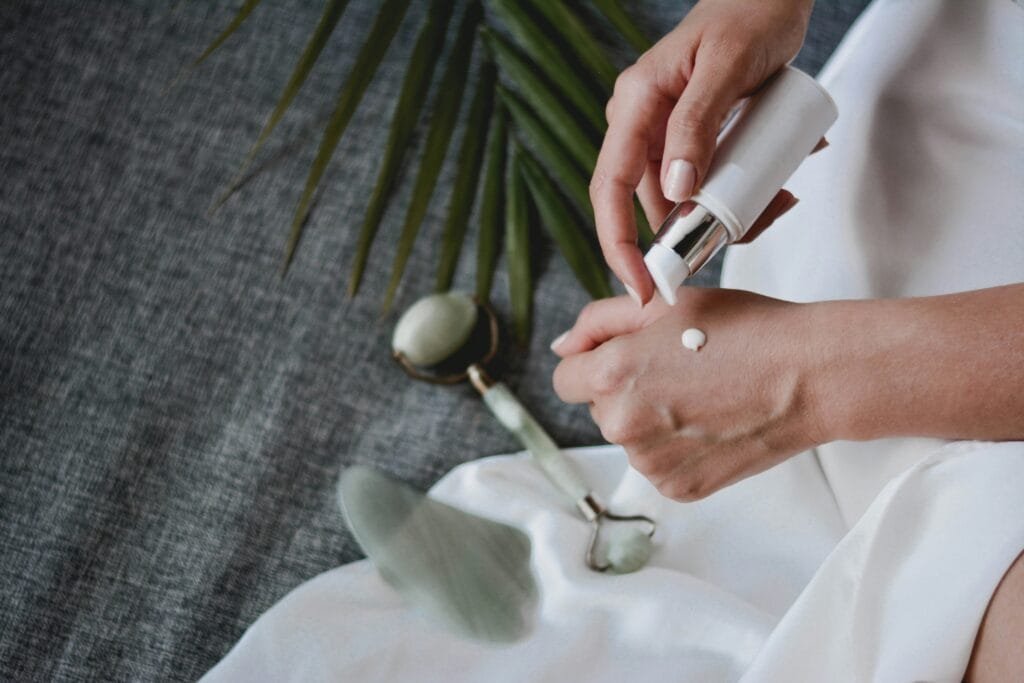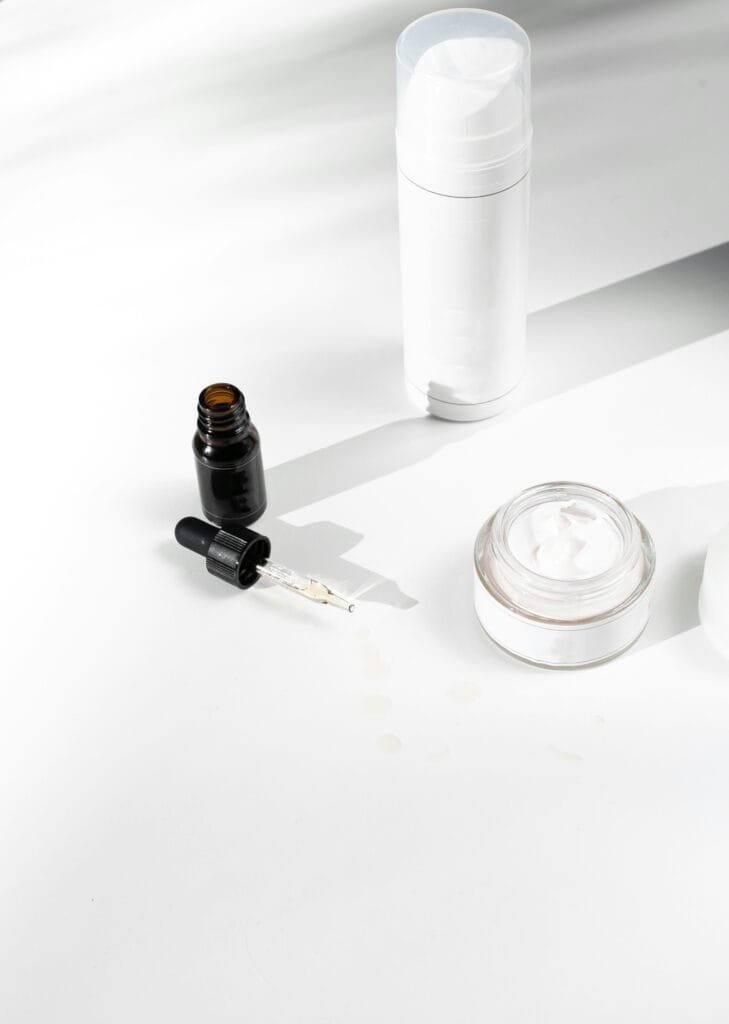I didn’t really think about skincare when I was younger. My skin care routine was essentially non-existent—just washing my face in the shower and maybe, if I remembered, putting sunscreen on at the beach or pool. That’s it. I didn’t really see the point of it back then.
Now that I’ve been embarking on a more comprehensive self-care journey, I’ve realized that skincare is bigger than trendy products. It’s not always for the sake of some desire to look younger. It’s about giving myself a tiny window of peace in my hectic day-to-day. It’s an act of caring for myself, in every sense. Standing at the sink, softly washing my face, or smoothing a cream on feels like a daily reminder to slow down and nourish myself.
The most basic of skincare routines is three steps: cleanser, toner, and moisturizer. I started out simple and cheap, with drugstore brand cleanser and moisturizer, and witch hazel toner. But the more I learned about my skin and what it needs, the more I realized that skincare is all about knowing your skin type, listening to how it reacts, and choosing products that love it rather than clogging it.

Understanding Your Skin Type
Before diving into products, it’s important to know your skin type. Everyone’s skin behaves differently, and what works for one person can be irritating or ineffective for another. Here are the most common types:
Normal: Balanced, not too oily or too dry, with few breakouts. Pores are generally small and not very noticeable.
Oily: Produces too much sebum (oil) and is likely to cause shine, blackheads, and acne. Pores are larger and more noticeable.
Dry: Lacks enough natural oils and leads to flakiness, rough patches, or a tight feeling on the skin after cleansing. Skin might look dull.
Combination: Combination of oily and dry. The T-zone (chin, nose, and forehead) will be oily, but the cheeks will be normal or dry.
How to find your skin type:
After cleaning your face using a gentle cleanser, don’t apply anything else on it. Wait for a while, say an hour. If it is tight and uncomfortable, then you probably have dry skin. If you see noticeable shine everywhere, then you have oily skin. If there is shine only in your T-zone, then you probably have combination skin. If it feels comfortable and balanced, then you’re within normal range.
Choosing the Right Basics for Your Skin Type
All skin care routines start with cleansing, toning, and moisturizing, but the right products depend on your skin type.
Cleansers:
Normal skin: Lightweight foaming cleanser or cream cleanser for mild cleaning and balance.
Oily skin: Gel cleanser or foaming cleansers with salicylic acid to help control oil.
Dry skin: Moisturizing creamy cleanser with ingredients like hyaluronic acid or ceramides.
Combination skin: A light gel cleanser that cleans oil without drying excessively.
Toners:
Normal skin: Alcohol-free toners that include soothing ingredients like rose water.
Oily skin: Toners that include salicylic acid or witch hazel to evaporate the oil and open clogged pores.
Dry skin: Moisturizing toners that include aloe vera or hyaluronic acid.
Combination skin: Balanced products with gentle exfoliants, like glycolic acid.
Moisturizers:
Normal skin: Light creams or lotions.
Oily skin: Oil-free, gel-type moisturizers.
Dry skin: More hydrating creams that include shea butter or ceramides.
Combination skin: Light creams that moisturize without being greasy.

My Upgraded Routine
Once I learned what my skin type was, it was time to take it to the next level. What was originally three steps became much more intentional:
Double cleansing: I use an oil-based cleanser first (like Palmer’s Oil Cleanser or Banila Co’s cleansing balm) to remove sunscreen and makeup, and then use a gentle cleanser to actually clean the skin.
Tone: Every now and then I go to basics using Thayer’s witch hazel, but I also love The Ordinary glycolic acid toner when I require gentle chemical exfoliation.
Serum or mask: Based on the mood of my skin, I reach for It’sSkin Hyaluronic Acid Moisture Serum, a Vitamin C serum, or The Ordinary Salicylic Acid mask. When I feel like something a bit more natural, I make up a rose clay homemade mask using glycerin and clay.
Moisturize: CeraVe Moisturizing Cream is a go-to of mine when I’m in need of deep hydration, or Innisfree’s Dewy Glow Jelly Cream if I’m in the mood for something a bit lighter.
Useful Ingredients by Skin Type
As I started getting more into skincare, I started paying attention not only to the names of the products but also to the ingredients themselves. Some ingredients really stand out depending on your skin type:
For oily or acne skin:
Salicylic Acid (BHA): Penetrates pores and cleans them out.
Niacinamide: Balances oil production.
For dry skin:
Hyaluronic Acid: Hydrating powerhouse.
Aloe Vera: Calms and soothes.
Ceramides: Strengthen the skin barrier.
For combination skin:
Glycolic Acid (AHA): Gentle exfoliation to refine texture.
Lightweight oils: Like jojoba, which mimic the natural oils of the skin.
For dullness or age spots:
Vitamin C: Brightens and corrects pigmentation.
Retinoids: Stimulates skin cell turnover.
Ingredients to Avoid Mixing
With so many available, it’s easy to stack them all, but not all the ingredients get along. Below are some combinations to skip:
- Retinol and Vitamin C (too harsh and irritating).
- Glycolic Acid and Salicylic Acid (over-exfoliates).
- Benzoyl Peroxide and Retinol (they cancel each other out and will irritate).
When in doubt, swap products between morning and nighttime instead of piling them all into one routine.

Build-Your-Own Skincare Routine
Here’s a quick rundown to get you moving off the blocks, separated by skin type:
Normal skin:
Cleanser: Creamy or foaming that is gentle
Toner: Alcohol-free product or rose water
Serum: Vitamin C for glow
Moisturizer: Lightweight cream
Oily skin:
Cleanser: Salicylic acid-based or gel
Toner: Niacinamide or witch hazel
Serum: BHA or niacinamide
Moisturizer: Oil-free gel
Dry skin:
Cleanser: Moisturizing and creamy
Toner: Hyaluronic acid or aloe vera
Serum: Ceramides or hyaluronic acid
Moisturizer: Rich cream
Combination skin:
Cleanser: Gentle gel
Toner: Mild glycolic acid
Serum: Jojoba oil or niacinamide
Moisturizer: Light, balancing cream
Closing Thoughts
Skincare is no longer just products to me. It’s a kind of self-care practice. What started as drugstore basics has become a deliberate ritual, one that feels like care and connection to my body. Your routine doesn’t have to be expensive or complicated. What matters most is that it does the trick for your skin and feels good to you.
So whether you’re starting simple with a moisturizer and cleanser or building a five-step routine with masks and serums, remember that skincare isn’t ideal. It’s about giving yourself a little bit of time each day to treat yourself and thanking your body for getting you through the day.
Disclaimer: This content is for informational and educational purposes only and is not intended to be a substitute for professional medical advice, diagnosis, or treatment. Always seek the guidance of a qualified healthcare provider, such as a dermatologist, with any questions you may have regarding a medical condition, health concerns, or a new wellness routine.

